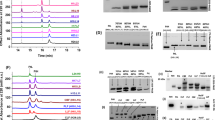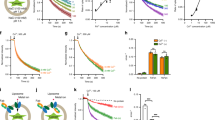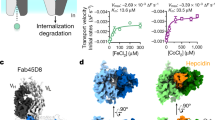Abstract
Plasma transferrin is involved in iron transport within the circulatory system of vertebrates, and provides an iron source for haemoglobin synthesis and other metabolic requirements. However, despite extensive studies by spectroscopic, biochemical and physiological techniques, the nature of iron binding and the mechanisms of uptake and release of iron are not fully understood. Plasma transferrins1 are monomeric glycoproteins with a molecular weight of approximately 80,000 (ref. 2); they have two similar and very strong binding sites for Fe(III), together with two associated anion binding sites. Fragmentation studies on various transferrins3–6 have shown that the polypeptide chain is composed of two domains formed from the N-terminal and C-terminal halves of the polypeptide chain. Each domain contains one metal binding site. The marked sequence similarities which exist between the two halves may reflect a doubling of an ancestral structural gene during the phylogenetic development of the protein2,7. Preliminary crystallographic investigations of diferric rabbit plasma transferrin have been reported from this laboratory8. We now report initial studies of the X-ray structure determination of diferric rabbit plasma transferrin which have led to a 6-Å resolution electron density map.
This is a preview of subscription content, access via your institution
Access options
Subscribe to this journal
Receive 51 print issues and online access
$199.00 per year
only $3.90 per issue
Buy this article
- Purchase on Springer Link
- Instant access to full article PDF
Prices may be subject to local taxes which are calculated during checkout
Similar content being viewed by others
References
Aisen, P. & Brown, E. B. Prog. Hemat. 9, 25–56 (1975).
MacGillivray, R. T. A., Mendez, E. & Brew, K. in Proteins of Iron Metabolism (eds Brown, E. B., Aisen, P., Fielding, J. & Crichton, R. R.) 133–141 (Grune and Stratton, New York, 1977).
Williams, J. Proteins of Iron Storage and Transport in Biochemistry and Medicine (ed. Crichton, R. R.) 81–89 (North-Holland, Amsterdam, 1975).
Brock, J. H., Arzabe, F., Lampreave, F. & Pineiro, A. Biochim. biophys. Acta 446, 214–225 (1976).
Line, W. F., Sly, D. A. & Bezkorovainy, A. Int. J. Biochem. 7, 203–208 (1976).
Evans, R. W. & Williams, J. Biochem. J. 173, 543–552 (1978).
Williams, J. in The Evolution of Metalloenzymes, Metalloproteins and Related Materials (ed. Leigh, G. J.) 17–38 (Symposium Press, London, 1977).
Al-Hilal, D. et al. J. molec. Biol. 108, 255–257 (1976).
Tickle, I. J. Acta crystallogr. B 31, 329–331 (1975).
North, A. C. T., Phillips, D. C. & Mathews, F. S. Acta crystallogr. A 24, 351–359 (1968).
Blow, D. M. & Crick, F. C. Acta crystallogr. 12, 794–802 (1959).
Author information
Authors and Affiliations
Rights and permissions
About this article
Cite this article
Gorinsky, B., Horsburgh, C., Lindley, P. et al. Evidence for the bilobal nature of diferric rabbit plasma transferrin. Nature 281, 157–158 (1979). https://doi.org/10.1038/281157a0
Received:
Accepted:
Issue Date:
DOI: https://doi.org/10.1038/281157a0
This article is cited by
-
Une nouvelle fonction pour la transferrine exprimée par le testicule
Basic and Clinical Andrology (2009)
-
The competition between transferrins labeled with59Fe,65Zn, and54Mn for the binding sites on lactating mouse mammary gland cells
Biological Trace Element Research (1998)
-
Apolactoferrin structure demonstrates ligand-induced conformational change in transferrins
Nature (1990)
-
Human lactotransferrin: Molecular, functional and evolutionary comparisons with human serum transferrin and hen ovotransferrin
Experientia (1983)
Comments
By submitting a comment you agree to abide by our Terms and Community Guidelines. If you find something abusive or that does not comply with our terms or guidelines please flag it as inappropriate.



